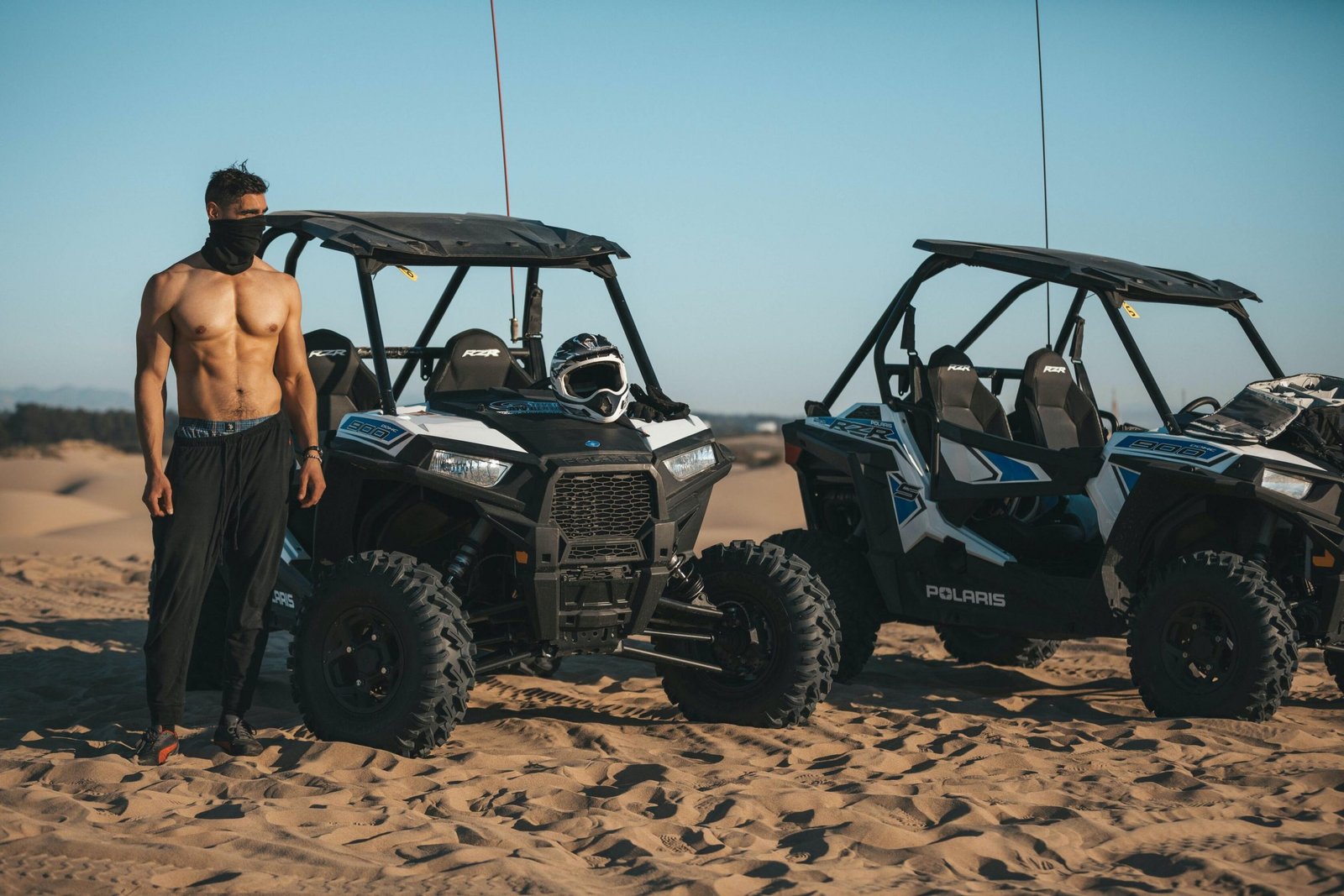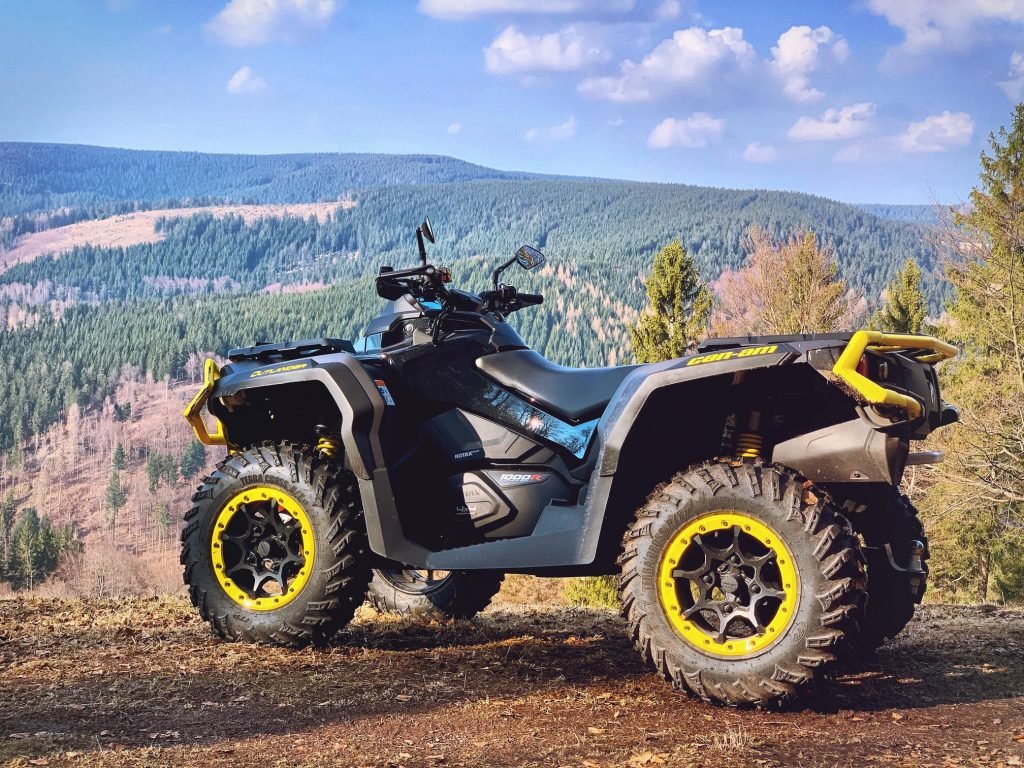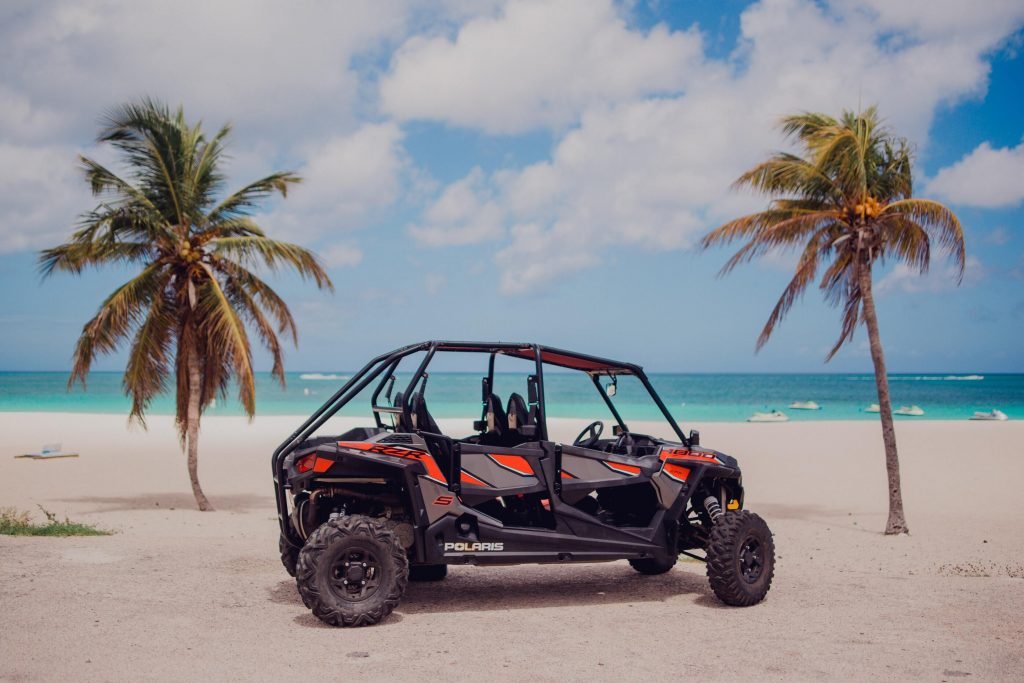Getting your snowmobile’s track adjusted correctly doesn’t have to be complicated. In this guide, we’ll show you the tools, step-by-step instructions, and troubleshooting tips for all major brands — Polaris, Ski‑Doo/Lynx, Arctic Cat, Yamaha, and more. If you do it right, your snowmobile will run great quickly. Why Track Tension Matters Track tension directly affects […]

What Is Difference Between UTV and ATV? 2025 Update
What Is Difference Between UTV and ATV?
Table of Contents
Introduction
Ever heard people talk about ATVs and UTVs when discussing off-road vehicles?
These machines are built to handle rough terrain and outdoor use. But they're quite different in what they do and how they're made.
Picking the right one depends on your plans, how many folks you need to transport, and the kind of ground you'll be driving on.
This guide will tell you everything you need to know about ATVs and UTVs. We'll explain how they differ, what's good and bad about each, and which one might work best for you.
What is an ATV?

An ATV
ATV means All-Terrain Vehicle, also called a quad or four-wheeler. These vehicles have a motorcycle-like seat that you sit on while using handlebars to steer.
Most ATVs fit one rider, but some can carry two people.
ATVs are small, have big tires, and a light frame. Thus making them great to drive on narrow trails, rough ground, and steep slopes.
Maybe you want to check:
Best Budget ATV Helmet Communication Systems
Unleashing the Thrill: A Comprehensive Guide to ATV Camping Adventures
What is a UTV?

A UTV on the sea beach
UTV means Utility Task Vehicle; People often call them side-by-sides because of how the seats are arranged.
Unlike ATVs, UTVs have a steering wheel, foot pedals, seat belts, and seats next to each other that can fit two to six people.
Most UTVs also come with a cargo bed in the back, letting users carry tools, gear, or other stuff.
Made for comfort and usefulness, UTVs are used to do work-related jobs, go on long rides, or transport several passengers.
ATV vs UTV: Key Differences
In order to help you know better about the difference between ATV and UTV, we have make a table:
| Feature | ATV (All-Terrain Vehicle) | UTV (Utility Task Vehicle) |
|---|---|---|
| Primary Use | Recreation, sport, off-road riding | Work, utility, off-road, recreation |
| Seating Capacity | Typically 1 rider, sometimes 2 | 2-6 riders, side-by-side seating |
| Steering | Handlebar steering | Steering wheel |
| Controls | Motorcycle-style, thumb throttle | Car-like controls, foot pedals |
| Cargo Capacity | Limited | Larger cargo space, often with cargo beds |
| Stability | Less stable, higher chance of tipping | More stable due to wider stance, lower center of gravity |
| Speed and Agility | Faster, more agile | Slower, more focused on torque |
| Terrain Handling | Excellent for tight trails, rough terrain | Great for varied terrains, not as agile in tight spaces |
| Comfort | Less comfortable for long rides | More comfortable, often with better seats and protection |
| Safety Features | Basic (helmets, protective gear) | Advanced (roll cages, seat belts) |
| Customization | High, with numerous aftermarket options | Also high, with many accessories and attachments |
| Cost | Generally less expensive | Generally more expensive |
| Maintenance | Typically easier and cheaper | Can be more complex and costly |
| Licensing and Regulations | May require specific licenses in some areas | Often requires licensing, more regulated |
| Use in Work Settings | Limited utility use | Extensive use in farming, construction, and other industries |
| Passenger Interaction | Limited, rear passenger may not interact with driver | Easier interaction between passengers |
| Weather Protection | Minimal, exposed to elements | Can have roofs, windshields, and doors for protection |
| Fuel Efficiency | Generally more fuel-efficient | Typically less fuel-efficient due to larger size and weight |
| Towing Capacity | Limited | Higher towing capacity for trailers and equipment |
| Electric Options | Available, but less common | Increasingly common with more models available |
Design and Dimensions
One of the most noticeable differences between ATVs and UTVs is their design.
ATVs are usually smaller and more compact. This makes them easier to maneuver through tight spaces like forest trails or narrow paths.
However, UTVs are wider, longer, and heavier. They often feature a roll cage and protective frame that gives them a more truck-like look.
ATVs are better suited for nimble movement and quick turns. UTVs provide a more stable ride, especially over rough terrain or steep inclines.
Seating and Carrying Capacity
ATVs are usually built for a single rider, though some models offer a small back seat for a second person.
They have limited storage capacity, typically using front and rear racks for cargo. These racks can hold a few hundred pounds, but they’re not ideal for larger or heavier items.
In contrast, UTVs offer far greater carrying capacity. Most models include two or more seats, allowing passengers to ride comfortably side-by-side.
The rear cargo bed can carry anywhere from 500 to over 1,000 pounds. Therefore, UTVs are an excellent choice for hauling equipment, tools, or supplies.

A man is driving an ATV on a dirt trail
Performance and Terrain
Both ATVs and UTVs perform well off-road, but they excel in different ways.
ATVs are built for agility and are great for quick turns, tight trails, and hilly terrain.
Their engines are usually smaller, ranging from 50cc to 700cc. Besides, their weight is usually lighter. These designs give them excellent speed and maneuverability.
UTVs generally come with larger engines, often between 400cc and 1,000cc or more. This allows them to handle heavy loads and long rides more comfortably.
Their suspension systems are built to keep the vehicle level even when carrying weight or riding over rough terrain. This brings the UTVs a smoother ride.
Safety Features
Safety is another key factor that separates ATVs from UTVs.
ATVs offer limited protection in case of a rollover or crash.
Riders must wear protective gear such as helmets, gloves, goggles, and long-sleeved clothing to reduce the risk of injury.
UTVs, on the other hand, are equipped with a variety of built-in safety features.
These often include roll cages, seat belts, doors, and sometimes even windshields and roofs.
While safety gear is still recommended, UTVs provide better protection in most situations.
Cost and Maintenance
ATVs are generally more affordable than UTVs.
A basic ATV might cost between $5,000 and $7,000, while premium models with more features can reach $15,000 or more.
Their maintenance needs are also simpler and less expensive((just do according to ATV maintenance checklist)). They often need limited to oil changes, air filter replacements, and tire checks.
UTVs start at around $10,000. And they can exceed $30,000 for high-end models with advanced features like GPS, heated seats, or enclosed cabins.
Usually, they require more maintenance due to their complex systems. These may include power steering, multiple drive modes, and advanced suspension setups.
Use-Case Scenarios

Men sitting on a UTV
Work Applications
ATVs are frequently used on farms and ranches to handle light tasks. These include checking fences, carrying small tools, or moving feed.
They’re fast and easy to maneuver, which makes them ideal for quick jobs over large areas.
UTVs are better suited for heavy-duty work. Landscapers, farmers, and construction crews often use them to transport equipment, haul materials, or tow trailers.
Their larger cargo space and multi-passenger capacity make them useful for team-based tasks or longer work sessions.
Recreational Activities
If you enjoy trail riding, hunting, or exploring the outdoors, both vehicles can serve you well. But in different ways.
ATVs are great for thrill-seekers who like tight trails, fast turns, and more physical control over the vehicle. Their nimble handling makes them a favorite for recreational riders.
UTVs provide a more relaxed experience. They are perfect for longer rides with family or friends.
They’re often used for hunting and fishing trips because they can carry more gear, passengers, and game.
Some even modify their UTVs for camping and overlanding. For example, outfitting them with roof racks, storage compartments, and even sleeping setups.
Seasonal and Specialty Tasks
In winter, both vehicles can be fitted with plows for snow removal. But, UTVs are more effective at clearing large areas due to their weight and size.
Emergency response teams and park rangers also use both types. They can be used for rescue missions, trail maintenance, or wildfire prevention. Among these 2 types, UTVs are the preferred choice when carrying equipment or injured individuals.
Pros and Cons
ATV Pros
- Lower purchase price and maintenance costs
- Excellent maneuverability and control
- Smaller size allows access to narrow trails
- Easier to transport with a small trailer or truck
ATV Cons
- Limited cargo and passenger capacity
- Exposed seating offers less protection
- Less comfortable for long rides
- Can be physically demanding to ride
UTV Pros
- Safer and more comfortable, especially for multiple passengers
- Larger cargo capacity and better hauling power
- Ideal for work tasks and extended trips
- Supports a wide range of accessories and modifications
UTV Cons
- More expensive to buy and maintain
- Larger size may limit trail access
- Heavier, which can affect speed and fuel use
- Requires more storage space and a larger trailer for transport
Cost Comparison
Price Range Overview
| Vehicle Type | Starting Price | Premium Models |
|---|---|---|
| ATV | $5,000 | $15,000+ |
| UTV | $10,000 | $30,000+ |
Ownership Costs
When you buy an ATV or UTV, you need to think about more than just the price tag. You should also consider how much you'll spend on gas, insurance, and repairs over time.
ATVs save you more on gas, with many types getting 30–50 miles per gallon. UTVs don't do as well on gas getting about 15–30 miles per gallon when they're carrying heavy stuff.
You might also pay the insurance costs. UTV insurance tends to be higher, especially if they are street-legal or used in commercial settings.
Both ATVs and UTVs have add-ons you can buy, like winches, plows, doors, and lights. But UTV extras often cost more and are trickier to put on.
Choosing Between an ATV and a UTV: When to Use Each
Use an ATV when:
- You Are Having a Solo Ride & Need Agility
- Tight Trails: Narrow, winding single-track or forest paths where a UTV can’t go through.
- Technical Terrain: Steep climbs, rock gardens, or rooty sections. The lighter weight and nimble handling of an ATV give you the edge.
- Need Quick Scouting & Errands
- Fast Recon: Jump on an ATV to scout hunting spots, check fence lines or survey property. Its quick throttle response lets you dart ahead and turn on a dime.
- Light Hauls: Use the small front/rear racks for toolboxes, feed buckets or a couple of small lumber pieces. It’s perfect for one-off, light-duty jobs.
- Want Lower Cost & Simpler Maintenance
- Budget Friendly: ATVs generally cost less up front and have fewer complex systems. No big cargo bed, roll cage, or doors to maintain.
- Easier Repairs: With simpler drive-train and suspension components, you’ll spend less time (and money) in the shop.
- Looking for Thrill-Seeker
- Adrenaline Rides: Lean into corners, hop logs, or send it over small jumps. The exposed, high-center-of-gravity ride is meant to feel more “alive” under you.
- Minimalist Setup: No doors, roofs or cages means a raw connection to the trail. It is perfect for riders who want to feel every bump.
- Limited By the Space
- Storage & Transport: ATVs take up less room on a trailer or in your garage. If you’re short on space at home or on the back of your pickup, an ATV will fit more easily.
Use Fodsports ATV Intercoms to Improve ATV Riding Communication
Use a UTV when:
1. Need to Carry More Passengers
- Group Rides: Seat two to six people side-by-side, so friends or family can ride together safely.
- Teamwork Tasks: Perfect for hunting parties, work crews, or family outings where everyone needs to tag along.
2. Require Heavy Hauling & Towing
- Large Cargo Bed: Haul firewood, feed, tools, building supplies, or game. The payloads of UTVs commonly exceed 1,000 lbs.
- Towing Capacity: Many models can pull trailers, sprayers, or implements. This can turn your UTV into a mini-tractor.
3. Farm, Ranch & Property Work
- Utility Chores: From moving fence posts to hauling hay bales and water tanks. A UTV is built for sustained heavy-duty use.
- Attachments Ready: Snow plows, sprayer booms, seed spreaders and more bolt right on.
4. Prefer Safety & Comfort
- Enclosed Cabin: Steel roll cage, seatbelts, doors/roof options and sometimes even heat or enclosure kits.
- Rough-Ground Stability: UTVs have wider tracks and long suspension travel. This keeps you steadier over ruts, rocks and washouts.
5. Need All-Weather & All-Terrain
- Mud, Snow & Sand: With stable footing and ample power, UTVs power through deep mud or dunes without flipping.
- Long Days: Comfortable seats and a smoother ride reduce fatigue on multi-hour trips.
6. Want a Beginner-Friendly Vehicle
- Low Learning Curve: Steering wheel, foot pedals and bench or bucket seats feel more like a car or small truck.
- Less Exposed: Enclosed protection helps new riders feel safer as they build confidence.
7. Need Easier Storage & Transport
- Trailer-Ready: UTVs fit easily on small utility trailers alongside gear.
- On-Site Parking: Some models even fold mirrors or have quick-release roofs for tight barns.
Choose Fodsports UTV Intercoms for Better UTV Riding Communication
How to Choose the Right Vehicle
Know Your Needs
Start by asking yourself how and where you’ll use your off-road vehicle.
If you mainly ride alone and value agility on narrow trails, an ATV is likely the better choice.
If you need to transport people, tools, or supplies, or want added safety and comfort, a UTV will suit you better.
Think About Your Budget
Beyond the sticker price, consider the cost of fuel, maintenance, insurance, and accessories.
If your budget is tight, a basic ATV offers great value and performance.
If you’re investing in a long-term tool for work or family recreation, the extra cost of a UTV may be well worth it.
Check Local Laws and Terrain
Before buying, research the trails and areas where you plan to ride.
Some places have width restrictions that prevent UTVs from entering. Others may have noise, emissions, or helmet laws that vary depending on the type of vehicle.
Also, check whether the UTV you’re considering can be made street-legal with proper modifications.
Common Questions
- Can I ride with a passenger on an ATV? Only if the ATV is built for two people. Most single-rider ATVs are not designed for passengers and may become unsafe if overloaded.
- Do I need a license to drive an ATV or UTV? In many areas, you don’t need a driver’s license, but you may need to complete a safety course or register your vehicle. UTVs used on public roads often require additional legal steps.
- Can both types tow a trailer? Yes, though UTVs can handle heavier trailers due to their larger engine and frame.
Conclusion
Both ATVs and UTVs offer powerful, off-road capabilities. But they’re built for different purposes.
ATVs are agile, affordable, and best for solo riding on tight trails.
UTVs are more comfortable, carry more gear and passengers, and are suited for work or long trips.
When choosing between them, think about how you’ll use the vehicle, what you need it to carry, and how much you’re willing to spend.
Taking a test drive, comparing models, and asking the right questions are also needed. These details can help you

With over 10 years of experience working on cars and trucks Item Training Supervisor Richard Reina is known around the office as one of our technical experts & real an "automobile person".
His rate of interest began, in his very own words, "at the age of two when his father educated him the distinction in between a Chevy and a Ford. Since then it's been cars regularly."
As a serious lover of practically all things with a motor Richard can address nearly any kind of inquiry related to car upkeep, fixing, or restoration & is a fact professional in electric motor background.
Motorcycle riding is all about the sense of freedom, adventure, and thrill of the open road. But come on—being connected when you ride isn't always an easy thing. Whether you're riding with a buddy, navigating traffic in the city, or long-distance riding, effective communication is crucial. That's where the Fodsports T5 and T6 come in, […]
If you're looking for a new motorcycle intercom system this year, Fodsports has something exciting in store. The company has launched two new Bluetooth helmet intercoms: T1 and T1 Pro. Both models bring upgraded features, sleek design, and high-definition audio quality for riders who want to stay connected, entertained, and safe on the road. But […]
Fodsports T1 and T1 Pro: The Newest Bluetooth Intercoms for Riders. Whether you’re cruising on highways, exploring rugged trails, or commuting daily, clear communication is key. Fodsports is thrilled to launch its latest Bluetooth intercoms: the T1 and T1 Pro. Built for riders who demand reliability, versatility, and crystal-clear sound, these devices redefine how you […]
Many riders who aren't so tall or ladies just starting to ride bikes need to pick out the best Motorcycles for Short Riders and Women. They gotta look for three key things: a seat that's not too high up, a bike that's not too heavy, and something that looks good enough to give them confidence. […]
Fodsports FX 60C vs FX30C Pro: What's new techs are the FX 60C bringing to us? Fodsports is a brand worth-mention for helmet communication and video recording. This brand has established itself as a key player with its innovative Bluetooth camera intercom systems. Recently, Fodsports has released a new camera intercom, the FX 60C. How […]

Hoeveel open deuren wil je intrappen met dit artikel.